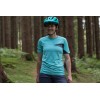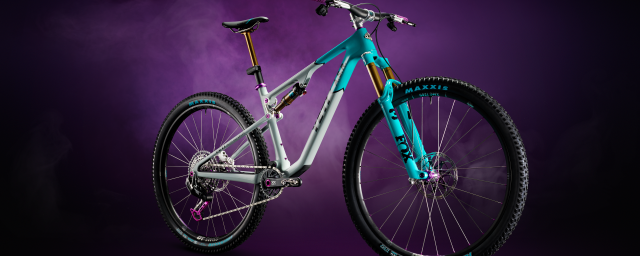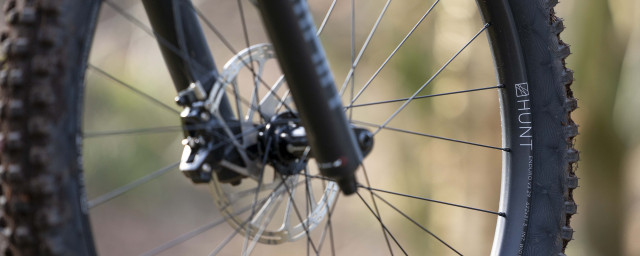
- Interchangeable optics allow complete customisation
- Good battery life
- Great remote allows you to operate more than one Gloworm light
- Three spot optics create a beam that is more focused than we'd like
- Battery pack needs silicone pad to prevent it marking the top tube
The Gloworm XSV is a seriously bright headlight that's easy to use, includes a useful wireless remote and offers tuneable optics. At £289 its power to price ratio is high, but while the battery gives good runtimes it's not without issues for frame mounting and fuel-level feedback.
- Top tips to make the most of the off-road night riding season
- Buyer's guide to getting the best off-road mountain bike and gravel front lights
- USE Exposure Diablo MK10 front light review
Kiwi brand Gloworm launched this back in the spring as the big brother to their XS front light. With three Cree XHP 50.2 LED's and packing a large number of lumens – 3400 to be precise – the whole package still comes in at just 430g with all the associated cables, strap and mounts.
It's designed as a floodlight and throws an even beam pattern out wide, which is ideal for a bar-mounted lamp. It's best when paired with a more focused beam on the helmet (we tested it with a 1,700 lumen Gloworm X2 Adventure up top).
The XSV comes with three 'spot' LEDs, but you can swap these for the 'wide' or 'flood' optics included in the box. I tested various configurations, but at first ran the three standard spots – best for seeing as far as possible, but rather hard-edged for a limited peripheral view. Next I went with a wide optic on the middle lamp to tune the hard edges of the beam. It worked quite well to soften them slightly, while the light was a little less focused overall.
I then tried the opposite with two wide optics flanking one spot optic. The light its thrown much wider in this configuration (see the pics for comparison) to illuminate more of the trail peripheries, without creating such a focused point in the middle. I quite like it for flooding the trail with light whilst using a more focused helmet-mounted light to pick out where I'm going.
The overall beam is still more narrowly focused than others we've tested, such as Exposure's MaXx-D, but it's better with the wide-angle optics and you won't notice any drop in light efficiency... though it is possible to fit them wrongly. Make sure to orientate the wide lenses with the ridged lines running vertically.
Your £289 gets you the waterproof light unit, a 6800mAh Lithium Ion 4-cell battery with a run time of 1.5 hours on unbroken full power, a wireless remote, extension cables for mounting the pack further down the top tube, and a host of mounting options, including the 31.8mm bar mount (it's £5 extra for a 35mm clamp).
The default settings are low, medium, high and super dim. The latter is very useful if you're sitting for some time and want to conserve power without being pitched into total darkness, and as it's a long press (two seconds) away you never have to cycle through it. There are also flashing options for road sections, and they're pretty bright. You can even customise the brightness of each mode in 10% steps with simple button presses (all detailed in the useful video here).
The bar mounted remote is easy to pair – simply attach the battery and press whichever button (there's two) you wish to use. You can pair the other button to another light if you're also using a Gloworm X2, or you can pair both lights to the same button and use the second as 'dip' and 'main beam'.
This is a great feature for saving battery on the climbs without having to fiddle around cycling through every mode for a descent. The only downside of a bar-mounted switch is, of course, that our bars are generally quite cluttered with levers and brackets already...
In its default settings, the XSV works very well. It's quite abrupt at the edge of the light field and has a much brighter center than some, which can reflect strongly off puddles and shiny surfaces, but it's more of a distraction than a hazard. These issues are all reduced, if not completely cured, with wide angled optics fitted.
Given the strong output, long battery life and neat little remote, however, these are foibles you can forgive.
The handlebar mount of the XSV fits to the left side of the light via an Allen key bolt. It's shaped to put the lamp central on the bars, which is a nice feature so often overlooked by other manufacturers. On the downside the mount does feel a little flimsy, although I found it to be secure, and it's a little fiddly to get the lever into the right position and at the right tension. At least you do only have to do this once a ride.
Mode-switching throughout a two-hour ride generally used about half of the battery life, with the time to empty being around four hours assuming you're dipping the power on the climbs. Pretty good going.
With the battery on the top tube the fuel gauge is nearly impossible to read – you have to lean down and peer at the end of the pack, and I couldn't read it when sat on the bike. The funky assortments of coloured lights can be hard to interpret as well, but you soon get the gist: the more orange there is, the more fun you've had, and the more red there is, the more trouble you're in.
Another problem with the battery: it can mark your top tube. Gloworm include a small stick-on foam patch for it, but it's not up to the job. It squashes easily and doesn't stop the raised ends of the casing leaving black marks on your frame. Gloworm is switching this to a silicone pad instead and since the publication of my review Gloworm are including the silicone pad with all XSV lights which I recommend you use, potentially by sticking it to the battery so you don't lose it.
If you don't want the XSV lighthead itself on the bars, at just 130g it's happy enough on your helmet with the battery in your pack. It's a wide unit and best suited to a place on the bars though, accompanied by a smaller light on your head.
The Gloworm XSV is a good light at a great price. With its alternative lenses there's more flexibility in the light patterns than we've seen before, its outputs levels are customisable and it's a reasonable weight given its runtime. As it comes, however, the light beam is a little more focused than we'd ideally like – and the only thing better than being able to tune it would be not having to tune it at all.

























Add comment